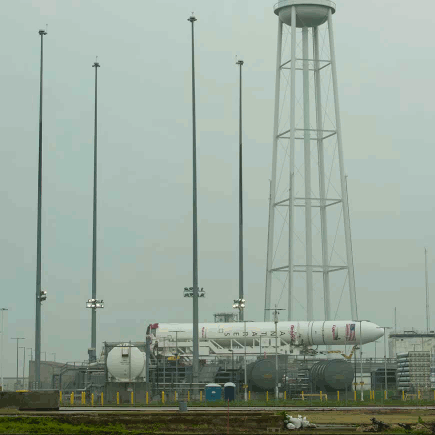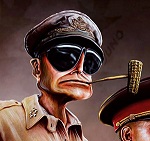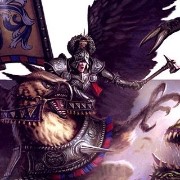|
xthetenth posted:Japan was also really uneven in terms of modernization, even into WWII. If I remember right, the prototype Zero, one of the better fighters of its day, was delivered to the airfield for testing by ox cart (not to be confused with oxcart, a much cooler option). Another big issue here for a lot of countries (even going back to WW1) was that they simply didn't have any domestic fuel(oil) supplies, even if you had the industry to build up a massive civilian truck&car fleet you had to make sure you had an alternative in case of your fuel supplies drying up/being blockaded during war (a lot of both Japan and Germany strategic priorities were fuel related during ww2). Let's just see what the New York Times had to say about it: quote:To Kaiser William II, it seems, we are indebted for the great, new industry,” said a New York Times magazine writer in 1906. “Not that he discovered the fuel, but that he forced its use on Germany. The Kaiser was enraged at the Oil Trust of his country, and offered prizes to his subjects and cash assistance … to adapt [alcohol] to use in the industries.” quote:In 1899, the German government organized the Centrale fur Spiritus Verwerthung (office of alcohol sales) which maintained alcohol prices at an equilibrium with petroleum at around the equivalent of 27 cents per gallon through subsidies to alcohol producers and a tariff on imported oil. Other incentives included scientific prizes, including a medallion from the emperor offered for the best alcohol engines. As a result, alcohol production rose from 10 million gallons to about 26 million gallons between 1887 and 1904. Even up to the second world war it wasn't such a sure thing just how long oil would last, so a lot of countries without a domestic supply of oil (and the US too, in a sort of 100+ year mirror of what's going on today) tried out various alternatives. Pretty much any biofuel or fossil-fuel argument you read today, pro or anti, you can see in the 1920ies and 1930ies. Including this gem: quote:In contrast, it was clear at the end of World War II that eventually US oil reserves would be depleted. According to the US Tariff Commission in 1944:
|
|
|
|

|
| # ? May 17, 2024 01:18 |
|
gradenko_2000 posted:On that note, can someone do an effortpost on Soviet fighters in WW2? All I know was they started the war with a bunch of really maneuverable biplanes, then switched over to the LaGG and the MiG-3 and one other model I can't remember right now, and then I don't really know what else comes after that. Did Soviet fighters ever come up with something comparable to the P-51, late-war Spitfire, FW-190? Sure why not In the early 1930s the Soviet government was all about airplanes. They developed some amazing planes like the ANT-25 that were as impressive as anything the west was building and then touted these as propaganda pieces. They also kind of accidentally created what was absolutely the best fighter in the world in 1933, the Polikarpov I-16, which had performance comparable to the front line fighters of most nations in 1939. Alongside the I-16 they developed a couple of fairly useful biplane fighters, the I-15 and I-153. Then...nothing happened. For 6 critical years. During this time Germany developed the Bf-109, the Brits got their Spitfire and Hurricane, the US got the P-39/40 and the F4F, and the Japanese got their Ki-43 and the Zero. Things first started to look hairy in Spain, when the I-15/153/16s pretty much had their way with earlier German biplane fighters and then...got completely jacked by the early model 109s when they showed up. Similarly, Chinese I-15/16s got torn up badly fighting against newer (but not top of the line) Japanese fighters. As a result some bureaucrat in 1939 decided that the VVS REALLY needed a new fighter plane or two or three. So, about 3 years too late, new requirements were drawn up the next generation of Soviet fighters. Three main designs were submitted: the MiG-1/3, the LaGG-1/3, and the Yak-1. These three designs (primarily the last two) would basically become the basis for of the VVS fighter force for the remainder of the war. At around the same time, new designs for a light tactical bomber (the Il-2) and a twin engined tactical bomber (the Pe-2) were making their first flights; both would eventually be world beaters. So, all of these new designs were promising, but at the time of Barbarossa most of the VVS was still in I-15/153/16s. A handful of LaGGs had made it to squadrons, but there weren't many other modern types available. That, plus poor pilot training, a gutted officer corps, and a complete lack of preparedness basically let the Luftwaffe annihilate the VVS where it stood through the first few weeks of Barbarossa. The sheer number of planes lost was staggering...4000+, against less than a hundred Luftwaffe losses. So, the VVS essentially had to rebuild from scratch. Fortunately, they had some quality designs to work with and they were given some excellent equipment through Lend-Lease. Until fairly recently, people thought of the post-1941 VVS as being a conscript air force with gobs of primitive equipment. It was, to a certain extent; they never developed effective high altitude bombers or the big shiny fast fighters to escort them, nor did they develop big sexy rugged naval aircraft. But, when you look at the Red Army requirements and what the VVS wanted to accomplish, they designed aircraft that were perfectly suited to the way that they wanted to fight. Basically, all weather tactical air power, specifically close air support and interdiction, were the name of the game. Everything the VVS flew during the war supported these two missions. What this required: 1) Planes that are simple to maintain, even in extremely difficult conditions. These aircraft are operating close to the front lines often on unimproved fields and with minimally trained maintenance personnel, so simplicity and ruggedness are paramount. 2) Planes that are tough as balls. When you're a) flying almost entirely at low level and b) flying against the Luftwaffe of 1942-43, you're going to be taking a LOT of punishment. Having planes that can take hits and keep flying (and are then relatively easy to repair) is extremely valuable. 3) Excellent low altitude performance. In order to let the attack aircraft do their thing, you have to maintain at least local air superiority. This means you have to field aircraft capable of winning dogfights at low altitude over all other performance characteristics. 4) Easy to fly. You're basically building a new air force from scratch and it isn't like your pilots were world beaters to begin with. Best to keep things as easy as possible. Literally everything else: range, high altitude speed, payload, etc, were secondary to these three requirements. As a result, the VVS wound up fielding the most formidable tactical bomber of the war (the Il-2) and the best low altitude air superiority aircraft of the war (the Yak-3 and the La-7). About the aircraft types specifically, the LaGG-3 was a reasonable first effort that was utterly transformed when a giant radial engine replaced the liquid cooled V-12 it had been fielded with. This turned it into the La-5, then the La-5FN, and eventually the La-7. The La-5 was the first VVS aircraft that was capable of really taking on the 109 on more or less equal terms, and at low altitude (where the Russians wanted to fight) it was decidely superior. Soon after, the Yak-1 was developed into the Yak-9, which became most produced Soviet fighter of the war. The basic Yak-9 was capable of holding its own against the 109 and 190; it was also extremely versatile (developed into high altitude, long range, and lol huge cannon variants) and eventually proved to be extremely potent once a new engine was installed. This upengined variant (the 9U) hit the streets in late 1943 and was the fastest fighter in the world at the time. At about the same time, Yakovlev was developing a pure dogfighter version of the Yak-1: the Yak-3. It was smaller than the -9 but with the same engine; as a result it was arguably the best performing aircraft in the world when it became operational. When it recevied the same engine upgrade it became, in my opinion, the best pure air superiority fighter of the war, though it was more difficult to fly and maintain than the -9 variant. Interestingly, the most promising of the 1939 designs, at least in terms of performance, was the MiG-3. It was, essentially, the tiniest airfame that could be built around the biggest inline engine available. It was the only VVS aircraft that could outperform the 109Fs and early Gs and the 190A in 1941, but it was difficult to fly, difficult to maintain, and performed poorly at low altitude...and so was largely ignored in favor of the less flashy models. As for the bombers, the Il-2 doesn't need much more written about it, but the Pe-2 is one of the more underappreciated designs of the war. It was easily the equal of the much more famous Mosquito in just about every way and its performance throughout the war was pretty exceptional. A slightly later design (the Tu-2) was, along with the A-26, the best twin engined tactical bomber design of the war in my opinion, though it wasn't produced in nearly the same numbers as the Pe-2. The Soviets concentrated so heavily on these aircraft types that they kind of neglected the future; as a result they had no competent long range bomber nor any decent jet fighters as the Cold War dawned. Fortunately for them they were able to steal both of these things from the West and thus caught up pretty quickly.
|
|
|
|
You know, that's extremely interesting. What did the Germans do in WW2?
|
|
|
|
brozozo posted:Can you expand a bit on mission capability and zero utilization? I don't know that much about the Space Shuttle. Well it's a couple things, most prominently funding. By the end of the Apollo Program, it was clear that there wasn't going to be enough funding from Congress to keep a purely civilian space program going, which meant NASA was essentially forced to go to the military, and provide a vehicle that could also carry out military missions. It had the massive wings to give it enough cross range to do single-orbit and return, and was reinforced enough to land with a big rear end satellite in the bay, the idea being that they could covertly snatch Soviet satellites I think. The part where it had massive wings and a huge cargo bay is what gave the Soviets the impression that it must have had some super-secret military mission they hadn't figured out yet, and hence why Buran was built. This MIT lecture covers the background of the Shuttle pretty well as I recall, and the series is pretty great in general. If you watch any documentaries on the American space program that goes beyond just the astronauts, you'll see a bunch of these guys in it. Obviously nobody was ever insane enough to try and steal a Soviet satellite, and while there may have been a normal reason to return with a satellite (originally they thought about doing this with Hubble I think), But once you accept the mission realities forced on it by politics, the Shuttle is still an amazing vehicle. The SSME (aka RS-25) is a reusable design (though it cannot reignite on orbit), and one of the most efficient high-thrust engines ever built. Possibly the most efficient LH2/LOX engine ever built, but some of the Russian designs might be up there with it. The tile system was at the very least a good idea, even if they turned out to be something of a hassle to work with, and made the first reusable spacecraft a reality. Ultimately the vehicle helped us build a space station, has repaired and upgraded Hubble on multiple occasions, and conducted 133 missons between 5 orbiters. And the loss of Challenger was entirely preventable had management listened to their engineers. *Scratch that, STS-51-A actually did successfully retrieve two satellites that failed to reach their intended orbit. PittTheElder fucked around with this message at 22:16 on Jul 30, 2014 |
|
|
|
JaucheCharly posted:You know, that's extremely interesting. What did the Germans do in WW2? Secured oil sources in allied countries (e.g. the huge Romanian fields at Ploesti) and doubled down on synthetic coal-to-oil conversion schemes for the most part. They also made driving for semi-near by oil reserves a bit of a strategic objective - see the southern offensive in Russia in '42 that had the ultimate goal of the caucasus oil fields before it bogged down on the Volga. That never really amounted to much, though, so it was pretty much synthetics and thanking god that they had the Romanians in their pocket.
|
|
|
|
Cyrano4747 posted:Secured oil sources in allied countries (e.g. the huge Romanian fields at Ploesti) and doubled down on synthetic coal-to-oil conversion schemes for the most part. Which was dumb because everything I've seen written on the matter says that the Russian oilfields were too low grade for German needs and could never have been useful even under the best circumstances.
|
|
|
|
Alchenar posted:Which was dumb because everything I've seen written on the matter says that the Russian oilfields were too low grade for German needs and could never have been useful even under the best circumstances. Really? Care to expound on that? I know gently caress all about the science behind it, but I was under the impression that oil quality really only affects the refining process, and that refineries can be (indeed need to be) tuned to work with the specific chemistry of whatever black sludge they're being shipped. I've always gathered that this is a giant pain in the rear end in today's economy because companies lose tons of money if they need to shut a refinery down for a few months to re-jigger it for oil from another source due to whatever reasons, but that seems like it would be less of a concern in the middle of a war for national survival. At the end of the day (again, based on my limited understanding) while the percentages of various products and by-products that the refining process produces might be a bit different given lower or higher grade inputs, you're still going to get the broad refining spectrum (Gas, Petrol, Kerosene, Diesel, Heating Oil). Cyrano4747 fucked around with this message at 21:52 on Jul 30, 2014 |
|
|
|
PittTheElder posted:But once you accept the mission realities forced on it by politics, the Shuttle is still an amazing vehicle. The hell it is, the engines might be fantastic but a launch vehicle whose options in an emergency between launch and orbit are the RSO, engine explosions, or aerodynamic forces kill you up is a bad launch vehicle. Speaking of the RSO did the orbiter itself have explosives on it? I know the tank did at least.
|
|
|
|
MA-Horus posted:The Space Shuttle was originally designed to be a cheap, reusable platform to get relatively smaller payloads into Low Earth Orbit. The idea was that there could be a fleet of a dozen or more, and you'd have weekly launches, which would bring the cost down per vehicle. Keep in mind, though, that NASA *sought out* the USAF because the commercial interest in launching satellites could in no way utilize the enormous overcapacity NASA was promising. They figured with all the spy satellites the USAF needed to launch, they'd be interested, and they were, but that generated the polar orbit requirement, which meant a bigger launch rocket. And meant you can't launch out of KSC because now you're launching over populated USA or risking dropping a spy satellite on the Cubans.
|
|
|
|
Phanatic posted:Keep in mind, though, that NASA *sought out* the USAF because the commercial interest in launching satellites could in no way utilize the enormous overcapacity NASA was promising. They figured with all the spy satellites the USAF needed to launch, they'd be interested, and they were, but that generated the polar orbit requirement, which meant a bigger launch rocket. And meant you can't launch out of KSC because now you're launching over populated USA or risking dropping a spy satellite on the Cubans. There was a launch complex at Vandenberg though, I think they could have launched a shuttle into a polar orbit. I'm not sure why they didn't, I'm much more of an Apollo guy. Raskolnikov38 posted:The hell it is, the engines might be fantastic but a launch vehicle whose options in an emergency between launch and orbit are the RSO, engine explosions, or aerodynamic forces kill you up is a bad launch vehicle. Well the lack of a launch escape system is sort of forced on you by the design. And to be fair, in the design stage the solid rocket guys were sure they could find a way to turn off the solids, but then it turned out you can't. And no, no self-destruct on the Orbiter itself. Doesn't really need them, if it goes off course in powered flight the tank and booster detonation will take it out, and if it successfully separates in an abort scenario, the crew can just fly it to somewhere safe.
|
|
|
|
Azran posted:Obligatory mention of the LaGG-3. Also known as Guaranteed Varnished Coffin by their pilots. Or maybe it was and not varnished but the name still applies. Lakirovanniy Grob Garantirovan. The mnemonic was "lacquered", regardless of how the actual thing was covered.
|
|
|
|
PittTheElder posted:There was a launch complex at Vandenberg though, I think they could have launched a shuttle into a polar orbit. They could have, once they spent billions to build it, but the point is that to launch into a polar you need a bigger rocket because you're not getting as much free velocity from the eastwards component of the launch. The real damage came from the insistence of the aforementioned and ludicrous steal-a-Russian-satellite mission capability, because that in turn demanded and enormous cross-range capability which meant bigger wings on the orbiter, which meant more area to heat-shield, which meant more weight, which meant an even bigger rocket. quote:I'm not sure why they didn't, I'm much more of an Apollo guy. It took the USAF forever to get the Vandenberg complex ready for the Shuttle, and then Challenger happened. quote:Well the lack of a launch escape system is sort of forced on you by the design. Then that should be a factor that causes you to reevaluate the design, not excuse the lack of escape system. In fact, the escape system requirement was dropped in response to the redesign crunch caused by the USAF requirements for polar launch and 1000-mile crossrange. quote:And no, no self-destruct on the Orbiter itself. Doesn't really need them, if it goes off course in powered flight the tank and booster detonation will take it out, There wasn't even a detonation during Challenger, just a very large deflagration. Very big chunks of orbiter made it down intact, which is why you can't launch a polar profile out of KSC.
|
|
|
|
Phanatic posted:Then that should be a factor that causes you to reevaluate the design, not excuse the lack of escape system. In fact, the escape system requirement was dropped in response to the redesign crunch caused by the USAF requirements for polar launch and 1000-mile crossrange. Right, but as I've heard Dale Myers say, has they re-evaluated the design to the point where they seriously pushed back against the military requirements, there wouldn't have been a manned space program at all. That's not better. quote:There wasn't even a detonation during Challenger, just a very large deflagration. Very big chunks of orbiter made it down intact, which is why you can't launch a polar profile out of KSC. In a case of the orbiter disintegrating like it did, a range safety destruct wouldn't make a difference, because the charges would be separate from most of the bits. And to be pointlessly technical and pedantic, there was a detonation during Challenger, the RSO detonated the SRBs after the vehicle broke apart.
|
|
|
|
Ensign Expendable posted:Lakirovanniy Grob Garantirovan. The mnemonic was "lacquered", regardless of how the actual thing was covered. Are there many military acronyms that had their meaning modified in a particularly fun way by the troops?
|
|
|
|
The thing that still kinda blows my mind about the shuttle is that between Booster engine start and Booster Engine seperation, there is NO abort possible. None. Basically if there's a problem at any time in those several long minutes when you're riding two giant loving solid rocket boosters, you're riding it out until they're gone. Or until you die. It seems a very un-NASA-like approach, when previous designs had abort options at multiple stages. Which sometimes leads to hilarity like Gene Cernan's "SON OF A BITCH" on Apollo 10.
|
|
|
|
Anyone have a good resource about HALBERDS? I wanna learn all about HALBERDS. How they were used, who used them, why they were great and when they weren't useful, all that. Preferably online since I'm poor and don't have access to a great library. An effortpost would be cool too, alternatively, but I don't want to put anyone out. Also, separately, I'd love a really good resource for modern squad-level tactics. Pharmaskittle fucked around with this message at 01:54 on Jul 31, 2014 |
|
|
|
MA-Horus posted:The thing that still kinda blows my mind about the shuttle is that between Booster engine start and Booster Engine seperation, there is NO abort possible. None. Basically if there's a problem at any time in those several long minutes when you're riding two giant loving solid rocket boosters, you're riding it out until they're gone. Or until you die. Lack of escape possibility wasn't exactly virgin ground for NASA either, I certainly wouldn't have wanted to put my faith in the loving ejection seats on Gemini, and I think it's pretty telling that Schirra didn't either.
|
|
|
|
my dad posted:
Hummers and Jeeps.
|
|
|
|
PittTheElder posted:Right, it is scary as all hell, but the design was basically forced on them, and when the design work was happening, there was supposed to be a way to shut them down. Additionally, the solids themselves were about as safe as you can make such a thing; they should never have launched that day and a great many people knew it. You basically never want to put your faith in Ejection seats. Especially in the 1960s. Using them under just about any situation ended up usually prematurely ending whatever career you may have had, due to injury. Armstrong was very lucky that his ejection from the Flying Bedstead didn't hurt him more than a bit tongue.
|
|
|
|
Yep. And Schirra and Stafford are pretty lucky to have not exploded to death; must have taken some stones on Schirra's part to make the 'nah, I'm pretty sure it didn't lift off at all' call when your rocket engines cut out a second after ignition.
|
|
|
|
my dad posted:
SB2C = son of a bitch 2nd class, some other naval ones I think.
|
|
|
|
Wait Gemini had ejection seats?!?! Mercury had the capsule abort rockets why the hell did they drop them? Raskolnikov38 fucked around with this message at 02:25 on Jul 31, 2014 |
|
|
|
Also My rear end Rides In Navy Equipment but I'm not sure if that counts 
|
|
|
|
Raskolnikov38 posted:Wait Gemini had ejection seats?!?! It sure did. There's a couple reasons why they dropped the tower for Gemini:
|
|
|
|
"Well I guess I could buy the fuel argument as long as they weren't using n2o4 and UDMH." *checks Titan II wiki page* What the gently caress NASA, there's only a few other chemicals I want nothing to do with or not be near more than hydrazine or n2o4. Raskolnikov38 fucked around with this message at 04:27 on Jul 31, 2014 |
|
|
|
Pharmaskittle posted:Anyone have a good resource about HALBERDS? I wanna learn all about HALBERDS. How they were used, who used them, why they were great and when they weren't useful, all that. Preferably online since I'm poor and don't have access to a great library. An effortpost would be cool too, alternatively, but I don't want to put anyone out. This book is considered to be the preeminent guide on all hafted weapons (not just halberds) in medieval and renaissance Europe. It's rather expensive, but if you're interested in this stuff it's a great book to own. In the mean time, I'll try my best to dig up some (free) info for you. Until then, here's a video on pollaxe freeplay. 
|
|
|
Cyrano4747 posted:Really? Care to expound on that? I know gently caress all about the science behind it, but I was under the impression that oil quality really only affects the refining process, and that refineries can be (indeed need to be) tuned to work with the specific chemistry of whatever black sludge they're being shipped. I've always gathered that this is a giant pain in the rear end in today's economy because companies lose tons of money if they need to shut a refinery down for a few months to re-jigger it for oil from another source due to whatever reasons, but that seems like it would be less of a concern in the middle of a war for national survival. Oil 101 is a good book that describes the basics of the oil industry. http://www.amazon.com/Oil-101-Morgan-Downey/dp/0982039204/ref=sr_1_1?ie=UTF8&qid=1406779254&sr=8-1&keywords=oil+101
|
|
|
|
|
Raskolnikov38 posted:"Well I guess I could buy the fuel argument as long as they weren't using n2o4 and UDMH." That's only because you don't know enough chemicals! In terms of poo poo that gets played with in rocketry, Hydrazine is downright safe. http://library.sciencemadness.org/library/books/ignition.pdf Also, if anybody has any further space questions, come set your SCE to AUX in The Space Flight Thread, for all the rockets, satellites, stations, and explosions you can handle! 
PittTheElder fucked around with this message at 06:13 on Jul 31, 2014 |
|
|
|
StashAugustine posted:Also My rear end Rides In Navy Equipment but I'm not sure if that counts Math And Reading Is Not Easy
|
|
|
Panzeh posted:EMP is significantly overrated as a threat to electronics anyway. From a while back but can't you shield something from emp by basically just building a faraday cage type of thing with current put through it? Like a three-dimensional coil surrounding whatever electronics you want protected? bewbies posted:Sure why not Again from a while back, this is an awesome post. I find the yak-9 variants pretty interesting, too. "This is long range variant comrade." "And this? What is this??" "This is enormous patriotic cannon variant  " "The soviets understood the concept of doing things because they're badass perfectly well. edit: haha holy poo poo, 45mm! Imagine the design synopsis. "This aircraft can successfully engage any enemy fighter, bomber or ground vehicle up to and including Panzer IV" Slavvy fucked around with this message at 09:52 on Jul 31, 2014 |
|
|
|
|
Didn't it only carry 32 or so rounds?
|
|
|
|
Rabhadh posted:Didn't it only carry 32 or so rounds? It can destroy up to 32 Panzer IV tanks in a single run, comrade!
|
|
|
my dad posted:It can destroy up to 32 Panzer IV tanks in a single run, comrade! *returns to air strip, all rivets and panels rattle off simultaneously*
|
|
|
|
|
Slavvy posted:*returns to air strip, all rivets and panels rattle off simultaneously* That's shrapnel dawg.
|
|
|
|
Slavvy posted:From a while back but can't you shield something from emp by basically just building a faraday cage type of thing with current put through it? Like a three-dimensional coil surrounding whatever electronics you want protected? You can do lots of weird poo poo when you're drunk on Vodka 24/7 i mean hell, look at their Tsar tank...or even their flying tank
|
|
|
|
What's the difference between the topographical peak and the military peak of a ridge?bewbies posted:Sure why not Just wanted to say thanks for this! You're a true asset to the thread.
|
|
|
|
What's the largest calibre gun that has been mounted on a plane?
|
|
|
|
Verisimilidude posted:This book is considered to be the preeminent guide on all hafted weapons (not just halberds) in medieval and renaissance Europe. It's rather expensive, but if you're interested in this stuff it's a great book to own. Answer: Of course, it's academic publishing.
|
|
|
|
Fangz posted:What's the largest calibre gun that has been mounted on a plane? You probably aren't thinking of the AC-130 etc but here's my favorite (7,5 cm Pak 40): http://en.wikipedia.org/wiki/Hs-129#Hs_129_B-3
|
|
|
|

|
| # ? May 17, 2024 01:18 |
|
gradenko_2000 posted:What's the difference between the topographical peak and the military peak of a ridge? The topo ridge is the highest point. The military ridge is the highest point where you still have eyes on the bottom of the ridge line. So no one can sneak up on you
|
|
|







 Yes, it's like a lava lamp.
Yes, it's like a lava lamp.































